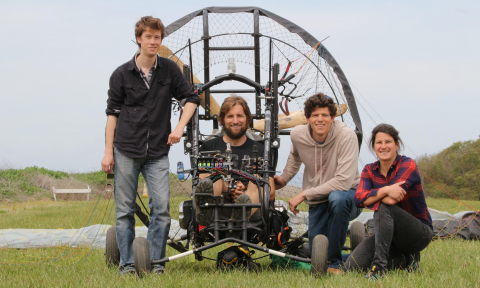How Camp Six Labs is Using Drones to Rethink Transportation on a Global Scale
How Camp Six Labs is Using Drones to Rethink Transportation on a Global Scale
by Cat Johnson
Camp Six Labs is working to bring high quality transportation to areas around the world. The Santa Cruz-based startup’s vision includes getting goods into areas with few roads—such as Northern Alaska, roads of questionable quality, and areas that have been hit by disasters, such as floods and hurricanes.
The Camp Six team is designing a transportation system that includes autonomous aircraft delivering large amount of cargo—up to 600 pounds—to remote and rural communities.
“We were very curious about understanding the potential of drones,” says co-founder Clement Gires of the company’s foray into autonomous aircraft. “We thought about using drones, rather than just taking pictures, to actually land and repair things. But we were also interested in the idea of carrying a much larger amount of cargo—something that could eventually supply entire communities at a time, not just deliver one Amazon package.”
Gires and his co-founder Hannah Droesbeke spent more than a year learning how to fly larger and larger drones. Eight months ago, they started assembling a team focused on the transportation angle.
“We really like transportation,” says Gires, “because once we prove we can move 600 pounds from point A to B, almost anywhere around the world has a use for that.”
One of the Camp Six values is social good. Gires believes access to transportation should be a right.
“So much of our lifestyles and our lives and our businesses rely on good transportation,” he says. “I think that poor transportation and poor infrastructure is a major factor in the lack of development in many parts of the world. If we can bring the same ease and speed and prices of transportation to those parts of the world, we’re hoping to have a pretty large impact.”
Camp Six currently has a 600 pound prototype model flying now out of the Monterey Bay Academy Airport about 10 miles south of Santa Cruz. The goal is to start the first commercial operations by the middle of 2019.
Potential Camp Six customers include shipping companies, consumers, remote communities and governments, in both the humanitarian and disaster relief sectors. As Gires explains, many remote communities get their goods delivered by plane, which is expensive, both in terms of dollars and environmental impact. In some areas and industries, such as mining, things are being flown in, sometimes by helicopter, which is very expensive and, on the consumer side, it’s prohibitively expensive for a shipping company to ship to rural areas.
“When they have a truck driving an hour with 100 pounds of payload in the back,” says Gires, “it’s hard to make it work.”
He also points out the cost of getting everyday supplies, such as groceries, can be for people in rural areas.
“If you live an hour from a grocery store, you probably spend several thousands of dollars a year just on trips to get groceries,” he says. “A very large part of the world’s population is in that scenario. More than one billion people live without access to good roads.”
The Camp Six team was originally based in San Francisco, but they relocated to Santa Cruz because of the lifestyle here. Gires has two young children and he wanted to “raise his family” here.
“We had the luxury of being able to relocate here,” he says, “so we did it.”
Before relocating, however, Gires had to make sure the move wouldn’t impede the company’s development. He soon found, however, that there’s a lot of high-quality talent already in the Santa Cruz area, and there are people who want to work here or relocate here. When Camp Six was in its early days, having access to a talent pool wasn’t high priority. Now that the company has secured seed funding and is hiring more software engineers and mechanical engineers, accessing top talent is key.
The Santa Cruz tech ecosystem and community is proving to be a rich pool to pull from. And the nearby Monterey Bay Academy offers what the company needs, at this point, to test and develop. Gires would like to see more areas opened up to emerging companies.
“Using the Monterey Bay Academy airfield has been very useful to us,” he says, “and so far, we’ve been welcome there.” He adds that “any local initiatives to use public or private land for the benefit of startups would be useful for Camp Six.”

